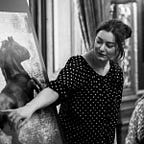Five Must-Know Art Techniques for Aspiring Equine Artists
Aspiring equine artists have a unique passion for capturing the beauty and essence of horses through art. In this blog, we will explore five essential art techniques that can elevate your equine artworks to the next level. Whether you are a novice or an experienced artist, mastering these techniques, will help you create stunning pieces. Let’s go!
Sketching with Accuracy
The foundation of any artwork starts with accurate sketching. Period. Observe horses closely, paying attention to their anatomy and proportions. Use quick, gestural strokes to capture the essence and energy of the horse. Begin with basic shapes to outline the major parts of the horse’s body, then refine your sketch with more detailed lines. Try to build 10 minute sketching sessions into your day, and notice the effect it will have on your hand — eye coordination. Remember, practice makes perfect.
Conveying Movement
Horses are known for their graceful movements, so capturing their motion in your artwork is essential. Study equine anatomy (‘Anatomy of the Horse’ by George Stubbs is a must) and observe their gaits to depict their movements accurately. Experiment with techniques like dynamic poses, blurred lines, and implied movement to convey a sense of action and energy in your artwork. This is where your 15 minute sketch sessions come in handy, to quickly transfer what you see onto the paper.
Creating Realistic Texture
Texture adds depth and realism to equine art. Mastering various texturing techniques allows you to portray the roughness of a horse’s mane or the softness of their fur. Experiment with different brushes, tools, and mediums to achieve the desired tactile quality in your artwork. Practice creating texture that enhances the overall realism of the horse’s features.
Mastering Colour and Tone
Understanding the interplay of colour and tone is crucial for creating realistic equine art. Study the different hues found in a horse’s coat and the way light affects them. Learn how to mix and layer colours to achieve depth and dimension in your artwork. Experiment with various brush techniques to capture the smoothness or texture of a horse’s coat. A good way to practice your sense of light and dark in the colour spectrum is to work with one colour only, creating a monochrome work.
Emotion through Expression
Do horses have facial expressions? Yes they do! The eyes and facial expressions play a significant role in evoking emotions in the language of a horse and thus also in equine art. Focus on capturing the soulful eyes and unique expressions of horses. Study their facial structure and practise portraying different emotions such as curiosity, affection, and strength. Pay attention to the subtle details that make each horse unique and bring their personality to life on the canvas.
Take your equine art to the next level, start practicing these techniques today and discover your own signature style in your art. And most importantly, have fun and enjoy what you do.
Equine Artist Collective
If you are an equine artist looking to connect with more like-minded spirits, why not have a look at our equine art community at Paard Verzameld, where you can showcase your creations, connect with fellow equine artists, and find opportunities to exhibit and sell your work.
For more equine art, please visit our website or get in touch directly.
Paard Verzameld | Equine art services
paardverzameld.com
